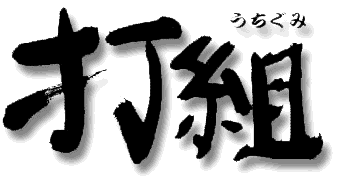



The Things I Couldnft Say Until Now
- Before Leaving United States
I am writing this before sunrise on my last day of a 12-day visit to the US,

October 20, 2008
TOMIDA KAZUAKI
![]()
| It is just past 5 am. I am looking at a world of darkness.
In the apartment where I am staying, I hear the Amtrak whistle. I am waiting for my last sunrise while in the US. Originally, I thought I would write my thoughts about this trip once I had returned to Japan. However, I am anxious. I want to get started now. I get out of bed. A cerebral hemorrhage. Itfs been five weeks since it happened. I had a stroke on the night of September 13th. When people ask me about the aftereffects of the stroke, I usually say, gIfm fine. No problem.h So many times, I have given this answer. I wasnft entirely wrong. However, after my stroke, I noticed that my body movements became slower. I didnft notice anything dramatically different. I was very lucky. But as days passed, I began to notice more and more differences. I returned to taiko workshops, practice for my December concert and private lessons. I slowly realized something was different. I discovered something everyday. Like the waves crashing on the beach. I began to worry. My worries increased with each passing day. At first, I wasnft able to talk about it nor could I write about it. I didnft want to cause my staff to worry too much just before going to the US. I also had difficulty accepting it myself. Fortunately, I did finally accept it after two weeks in the US. I would like to write about it here because I can believe that I can overcome it. My symptoms included weakness of my left fingers, shoulder, arm and wrist. I found that they donft move like they used to. For example, I cannot play gTamaireh of Chichibu Yatai-bayashi and the theme song for gBanraih with katsungi oke-daiko by myself. Do these examples make it easy for you to understand? I also find that I am unable to play at the tempo I want. I have particular difficulty using my left hand while playing the shamisen.
I have noticed that not only do I have difficulty playing the gchiri
rereh and gchiri chirih highlights of shamisen playing, but I also have
difficulty with the easy fingering. I can do the fingering slowly but
my hands donft move at the speed they used to. While playing taiko, fue and shamisen, my arm and finger movements used to flow as easily as water from the faucet. Years of practice resulted in an unconscious accumulation of skill within my body. Then I became ill after the 30th anniversary of my first public taiko
performance. One week after my stroke, I gave a concert. Strangely I didnft realize my limitations right away. At the time, I told myself gjust get back on stageh. I didnft understand the gravity of my situation because Eiichi Saito, one of the worldfs best taiko players, played alongside me during that concert. Maybe I did notice a few changes in my performing ability. However, I told myself, gIt canft be true. Ifll be fine.h But I knew that I could not play with Eiichi Saito forever. Once I began playing by myself, reality hit me. Then I left to go to the United States. I was expected to play on my own. I knew that it would be hard for me as a single taiko player. There would be no way to hide my limitations during the concert. At the time, I thought I could manage if I just remained positive. On the other hand, I couldnft help worrying that maybe I wouldnft be able manage it. My visit to US started with an uneasy feeling. I wasnft too concerned about leading the workshops. Still, I felt an underlying anxiousness which I kept it to myself. I felt nervous when I modeled taiko playing for the workshop participants as well as when I practiced taiko for the concert performance.
I had also been practicing the shamisen and felt that I could handle it. But the day before the concert, I found that my fingers still didnft move like I wanted them to. gThis cannot be. I must be able to move my fingers.h That is what I believed. But my fingers still did not move. The day before the concert, I disclosed my situation to Susan, the Emeryville Taiko representative. gWould you mind if I changed the shamisen song to a taiko song as I am finding that I am having difficulty playing the shamisen?h gI would prefer a shamisen song here due to the structure of the program.h gOf course, I agree. I would like to play. I have been practicing in the hopes of pulling it off. But I doubt that it will be a performance good enough for an audience.h gHmm....h gWell, Susan, I will play shamisen for you now and you decide whether you feel it is good enough. If you want, I will play shamisen at the concert.h And then I played at the dojo. That was the first time I was able to play the whole song without giving up or stopping. Susan said, gI think that your shamisen performance is just fineh. So I made up my mind to perform. The next day just prior to the concert, during the final rehearsal on the actual stage, I felt that my playing was awful. I couldnft play the very delicate rhythms on the taiko. I found that my fingers were not flexible. I didnft feel that my current level of concert performance was up to parc.I drank lots of water, made several trips to the restroom, and sweated profusely. Then I decided, I am not going to do the impossible. I will do what I can do and do my best. That would be the only way to play if I could not move to the grooves I had memorized in my body. Just before the concert began, I looked at my shamisen and taiko and thought, gShow time!h I donft think my face and body ever felt as stiff as it did before this performance. Normally, I do not get nervous. Before my stroke, I never felt any anxiety before a performance. I used to wonder was it OK to be this relaxed? Since the stroke, however, things have changed 180 degrees. Even after the concert began, I felt as if my smile was unnaturally stiff. Somehow, I managed to finish the concert. Completing each of my parts, one at a time, the concert came to an end. I walked through the center aisle at the end, playing taiko and shouting together with the other taiko players while the choir sang in the front of the church. There was a black night sky above us. I couldnft play as satisfactorily as before. But I did what I could. Satisfaction and dissatisfaction with myself -those two feelings swirled in my mind. In the end, I saw a glimmer of hope. I chose satisfaction over dissatisfaction. It came from the voices of the audience, the encouragement and the cheering, and the warm, smiling faces of the many people I met. Something changed the moment I saw those smiling faces. I doubt that there is another professional taiko player alive whose technique is as poor as mine in my current state. But if I refuse to give up and continue on my path, to improve my technique as a taiko player, I know that I will be able to continue to perform in Japan. I know that can overcome these feelings of uneasiness which still exists. The medical experts tell me that the brain cells that were damaged at the time of the stroke will not ever return to full functionality. But I know that that does not have to be the case. There are many people that have experienced strokes and have proven that they can recover fully. I have seen the improvement that one is capable of with hard work. I plan to keep playing, knowing that I too will be able to move and play taiko the way I used to. It isnft dawn yet. I close my eyes for a little while longer while I lay on the mattress on the floor. I feel a deep appreciation for the many people who took care of me and for the people I met while in the US.
(Translation/Takashi Sugumoto&Pat Stenglej
|
![]()
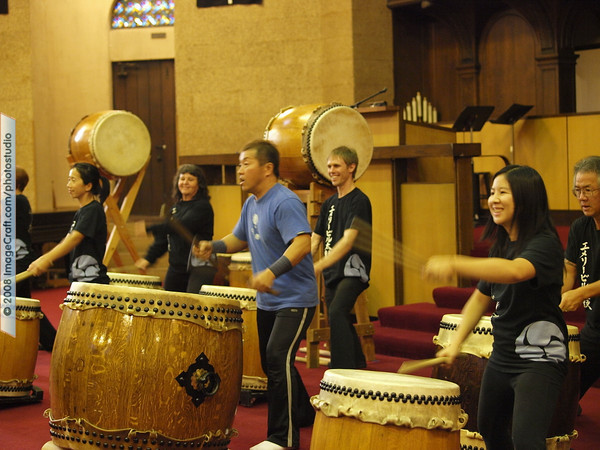
Rehearsal
![]()
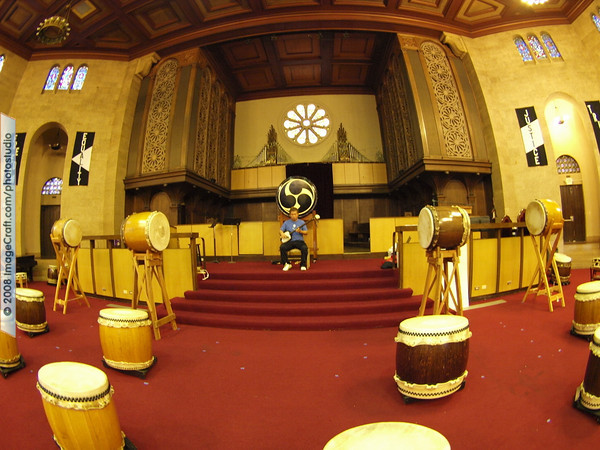
Rehearsal
![]()
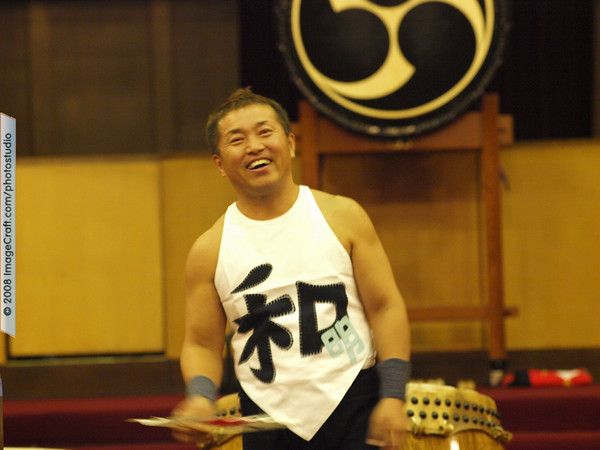
![]()
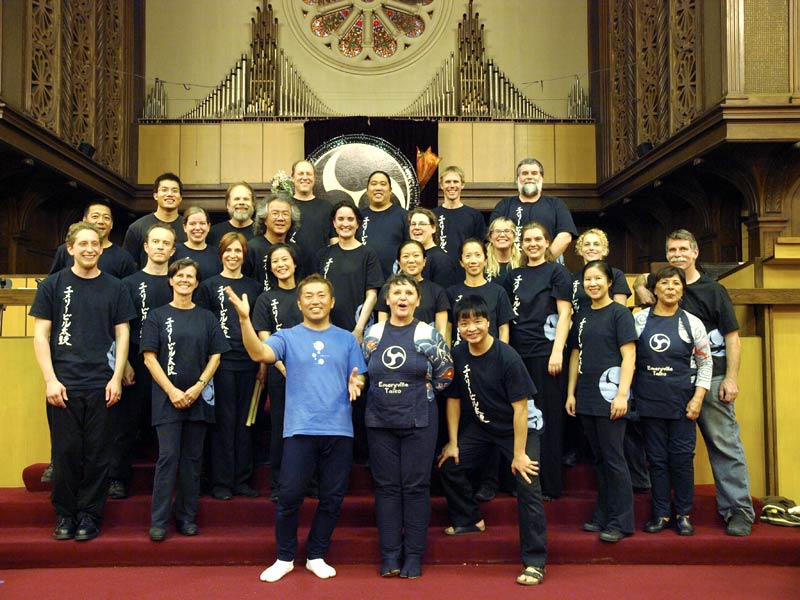
Saturday November 18th,
commemorative photo with members of Emeryville Taiko at First Congregational Church of Oakland.
Photo/Richard Man
![]()
![]()
| It has now been two weeks since I returned to Japan. I overcame my jetlag after one week. If I look back, it was a strange experience. Could I say that it was gkaidatsuh - the deliverance of my soul? I had that kind of experience the night of the concert.
For me, I think I needed taiko to begin to heal. By playing taiko, I connect with people. Taiko also helps me to grow, personally as well as professionally. Everyday, my mind wanders. I hope that I will be better tomorrow. If I donft improve tomorrow, I am sure that I will get better someday. I want to believe so. Everything happens for a reason. Meeting all of those people, experiencing those trying times cI think that is why I went (was invited) to the US. I cannot stop feeling a renewed energy. I feel so much appreciation. Thank you very much.
November 5th 2008 |
![]()
Photo/Susan in Emeryville Taiko Dojo
![]()
Internet Version wMonthly Uchi-gumix October 2008 Issue No.121
|

|